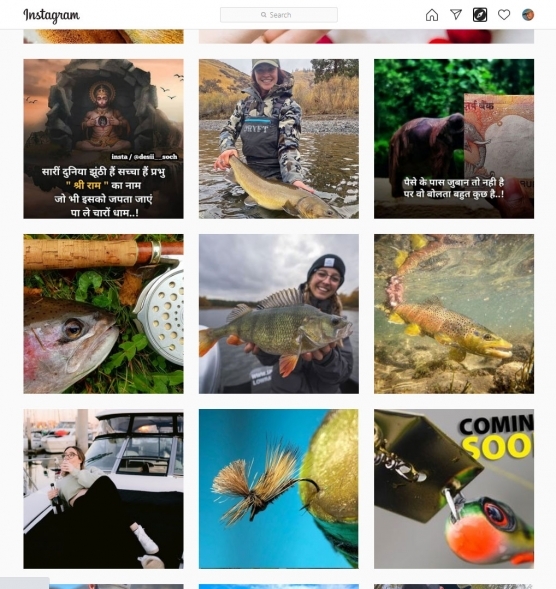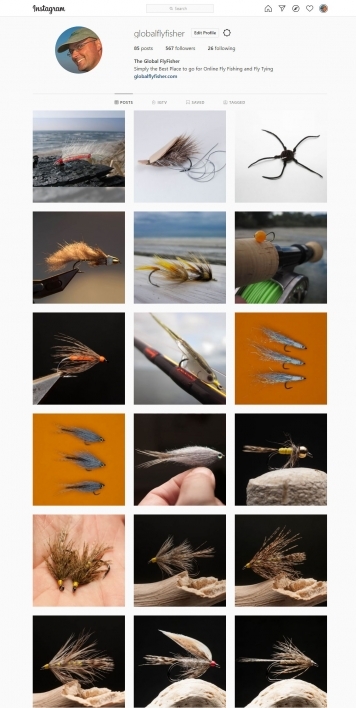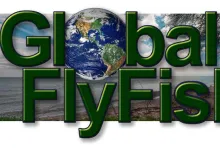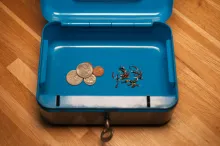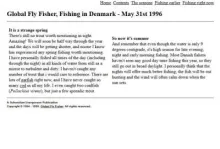Social media can be a strange experience. It's really a mixed bag. And on Instagram 40% of all anglers seem to be women!
I’m not an avid instagrammer, but I both post pictures there and sometimes browse images to see what’s going on.
I have to admit that Instagram hasn’t ever really grabbed me. I know that there are people who live and breathe for Instagram, but personally I’m not addicted.
I managed to open an Instagram account for the Global FlyFisher in the beginning of last year. The handle @globalflyfisher seemed free, but when I tried to claim it I was informed that it was taken. Since there were no users on instagram.com/globalflyfisher, I tried to pursue the matter a bit, and after some bickering with various anonymous Instagram support staff members and a few mails back and forth, I was suddenly granted access!
So https://www.instagram.com/globalflyfisher/ was a reality, and I could start posting images.
And so I did.
But I soon learned that being popular on Instagram and getting reactions is a question of likes and followers, and it’s kindof a follow-me-follow-you game. In order to get some traction you need to start following a lot of accounts, and many of them will then follow you back. This will mean that your posts are seen by more people, and as a result of that liked by more.
The other way of being visible on Instagram is by tagging. That’s when you add hashtag-words to your post like #flytying, #seatroutflies, #flyfishing and so on. The more and more skillful you do this, the further your posts will reach into the expanse of Instagram’s more than a billion users. With the correct tags your pictures can suddenly spread really wide. Bad tagging (or none) makes the image basically invisible to others than your followers.
But like other social media, many followers and “friends” means many posts in your stream, and visiting your SoMe-page is like standing under a hose of posts, which just gush out in an uncontrollable and sometimes overwhelming stream.
My own Insta-page isn’t that overwhelming, because until now I have only followed about 25-30 other accounts, and that’s not how it’s done! You need to follow thousands! And doing that is really opening the fire hose! Sure it might get you more followers and likes, but it also fills up your stream of incoming images with and endless conveyor belt of new images posted on the accounts you follow. And they aren’t all equally great or interesting…
I sometimes click on the Explore icon – the small compass in the top of the page – and that leads me to a page of all kinds of odd images. Most are fly fishing and fly tying, but for some reason I also get a ton of dog images (not cats, oddly enough) and quite a few with Indian actors and actresses with descriptions and comments in Hindi! Now, understanding Hindi is not exactly a core competence of mine, and I have no interest in Indian actors at all. Still… Instagram thinks I have.
Instagram also seems to think that some 30-40% of the world’s fly anglers are women. I know for sure that that’s not the case. It’s more like 3-4% if anything, and likely closer to 0.3-0.4% unfortunately. But on Instagram every 3rd or 4th image of an angler is a female one. That’s nice of course, and probably selected that way because all the male anglers have liked the images of the women, and Instagram thinks that I will too.
And that’s one of the ways of social media: algorithms! Clever and intricate ways of deciding what to show to who. Since Facebook, Twitter, Instagram and other social channels have billions of users, and you may have hundreds, thousands (or in some cases even millions) of people in your digital network, there’s no chance that you’d be able to follow what they are posting and commenting. So the various channels filter down these posts for you, and present you only the ones that for some reason stand out. Likes, comments, shares – interaction as it’s called – is gold on social media, and decides what floats and what sinks.
I mainly see flies and fishing in my Instagram stream, and can basically manage to see all that my contacts post, mainly because I have only added very few "friends". But when Instagram wants me to connect to more people a surprising number of these are women, in spite of women largely being underrepresented in the fly fishing community compared to the "outside world".
I usually kindly reject these offers to connect, and just keep on posting my images of flies from the Global FlyFisher.
- Log in to post comments

